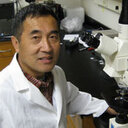Ouabain-induced cochlear degeneration in rat.
Sleutelwoorden
Abstract
Ouabain, a potent inhibitor of the Na+/K+-ATPase pump, selectively destroys spiral ganglion neurons (SGNs) in gerbils and mice, whereas in guinea pigs it preferentially damages cochlear hair cells. To elucidate the effects of ouabain on the rat inner ear, a species widely used in research, 5 μl of 1 or 10 mM ouabain was applied to the round window membrane. Distortion product otoacoustic emissions (DPOAE) and auditory brainstem responses (ABR) were used to identify functional deficits in hair cells and neurons, respectively, and histological techniques were used to characterize cochlear pathologies. High-frequency ABR thresholds were elevated after treatment with 1 mM ouabain, whereas DPOAEs remained normal. In contrast, 10 mM ouabain increased ABR thresholds and reduced DPOAE amplitudes. Consistent with the physiological changes, 1 mM ouabain only damaged the SGNs and auditory nerve fibers in the basal turn of the cochlea whereas 10 mM ouabain destroyed both SGNs and cochlear hair cells; damage was greatest near the base and decreased toward the apex. The nuclei of degenerating SGNs and hair cells were condensed and fragmented and many cells were TUNEL-positive, morphological features of apoptotic cell death. Thus, ouabain-induced cochlear degeneration in rats is apoptotic and concentration dependent; low concentrations preferentially damage SGNs in the base of the cochlea, producing an animal model of partial auditory neuropathy, whereas high concentrations damage both hair cells and SGNs with damage decreasing from the base toward the apex.


